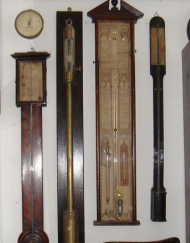
The Barometer
After the experiments carried out by Torricelli in 1644, by Pascal at the Puy-de Dome in 1648 and by Otto Van Gueriche of Magdeburg, mercury baromoters, with U-shaped tube, started to be produced in large numbers. In 1666, one certain Mr.Hooke, an English maker, invented the first needle barometer, also known as wheel barometer, which would serve as a prototype for all the wall barometers and quadrant barometers of the 18th century. These barometers – both direct reading barometers with visible liquid level, and indirect reading barometers, i.e. barometers with a dial – didn’t provide any vague indication of good or bad weather. Gimbals nautical barometers were remarkable for their sculptures and decorations and often included maximum minimum thermometers and hair hygrometers. The earlier ‘reliable’ barometers date back to the beginning of the 19th century.
Going back to the principle of Torricelli’s Tube, two types of barometer were created: First, the basin barometer which, like the Tonnelot and Kez barometer in which the basin surface is 100 times the tube diameter, is provided with a vernier for the reading, which is activated by a rack. Second, the Fortin barometer. Mercury in the cistern is held up by chamois skin with a screw underneath which is needed to adjust the 0 mercury level. A screw is used to compress the leather and calibrate the barometer by adjusting the lower mercury level to coincide with a reference mark, an ivory pointer – the 0 mark – also known as “witness”. The main scale on which the reading is done consists of a vernier scale graduated in mercury millimetres. While in England, barometer scales were graduated in inches, with a vernier scale in 1/20 of inch. The French Navy adopted a marine barometer from 1880. This was based on the Gay-Lussac principle and was perfected by Bunten. It was characterised by a kind of funnel on top of the basin. This barometer was mounted on the ship railing through gimbals, so that there was enough space to compensate the roll of the ship. Due to some defects, these types of barometers were soon replaced by aneroid barometers. These latter are of two types: the Bourdon barometer, with a curved and elliptical vacuum metal tube. Pressure variations deform the elliptical section and widen or reduce the circle diameter. These small deformations, when properly amplified, are used to activate an index in front of a dial or a pen on a drum recorder. The Vidi barometer uses vacuum metal capsules with a compensating spring preventing deflection due to atmospheric pressure. The deformations due to pressure variation are amplified and recorded by a pen, or shown on a dial. The more the capsules, the more sensitive the barometer. Aneroid barometers are less precise than mercury barometers, mainly because metal flexibility is unstable over time. Aneroid barometers are then needed to gauge pressure variations rather than and its value. In France, Richard was the main maker of these instruments. The first thermometer for kitchen use was probably built in Florence in 1641. It worked with alcohol extracted from wine. Its graduation was made at random: the 0 value coincided with the freezing point of water, but the “heat” value was associated with the melting point of butter.
Thermometers existed from the 18th century. Although not having a proper graduation, they were useful to sailors to gauge how far the polar ice pack or warm or cold fronts were. A very common thermometer was the deep sea reversing thermometer, used by oceanographers. It was used on a daily basis by ocean fishermen in order to determine the right layer of water with a temperature suitable for certain fish species. It was a simple method to ensure a good fishing.
|